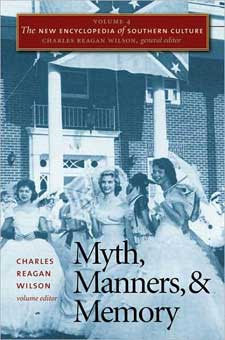
Book Review
The New Encyclopedia of Southern Culture Volume 4: Myth, Manners, & Memory
Chapel Hill: University of North Carolina Press, 2006
xviii + 297 pages. Index
$39.95 (cloth), ISBN 0-8078-3029-1; $19.95 (paper), ISBN 0-8078-5692-4
The original Encyclopedia of Southern Culture, encompassing some 1,600 pages, was released in 1989 to wide acclaim and quickly became the standard reference in the field of Southern Studies, featuring topical sections on history, agriculture, ethnic life, law, science and medicine, literature, violence, and more. However, even in 1989, the South was already undergoing tremendous demographic and cultural change, and the relatively new field of Southern Studies was adopting new analytical techniques that were leading to new insights into the culture and history of the region. It soon became readily apparently that this classic encyclopedia would need updating in order to remain a relevant resource for modern students. Rather than make an already huge volume even weightier with additional material, the editors decided that The New Encyclopedia of Southern Culture would be comprised of individual, thematic volumes released separately. This allows for the expansion of articles to include recent developments or new scholarship, as well as the inclusion of articles that were not part of the original encyclopedia. Not only have the entries been updated, but so have the bibliographies, thus pointing the reader to the latest research and most comprehensive on any given subject.
Myth, Manners, & Memory, the fourth volume of The New Encyclopedia of the South, combines parts from the “History and Manners” and the “Mythic South” sections of the previous edition to provide a greater focus on how the South’s view of itself influences Southern custom and culture. The result is sure to be one of the cornerstone volumes of this series, covering a range of topics such as “Confederate Monuments,” “Romanticism,” “Sexuality,” “Fashion,” “Debutantes,” and more—the whole breadth of Southern social life and mythic consciousness. Among the entries new to this edition are “Clocks and Time,” “Etiquette of Race Relations in the Jim Crow South,” “Fatherhood,” “Ladies and Gentlemen,” “Tobacco,” “Victorianism,” and “Visiting,” as well as shorter profile pieces on subjects such as “Black Collectibles,” “Christmas,” “Graceland,” and “Trucking.” All of this is introduced by a short essay at the beginning looking at how mythology has played a role in the shaping of Southern identity and how manners and memory are linked to that mythology. One thing I most enjoy about this particular volume is that it examines those characteristics of Southern life so common as to be almost invisible, such as the simple act of visiting. The whole encyclopedia series does particularly well at not examining the South in isolation, and that is true for this volume, which features an analysis of Northern mythmaking about the South as well as the stereotypes of Southerners held by those outside the region (there is, indeed, even a separate piece on “Mencken’s South”).
Working as I am on the second encyclopedia project of my career, I tend to be a bit sympathetic toward other encyclopedias I encounter, for putting one together is an exercise in imperfection. Encyclopedias are collaborative projects that may rely upon hundreds of authors scattered around the nation and the world, each with their own academic backgrounds and writings styles, as well as their own particular set of priorities, and it is the poor editor’s job to weave all the entries together into a seamless whole—that is, provided he can actually get them from the author. Where many critics see inexcusable gaps in an encyclopedia’s range of entries, I imagine a desperate editor yet again phoning an author who has long since stopped answering, trying feverishly to get something in before the deadline for publication.
That said, this is a book review, and there are some small omissions in the volume under consideration. Feuding is covered but not dueling, which was intricately tied up in Southern codes of honor and chivalry, and though no longer formally acceptable in the current school of Southern manners, it remains deserving of analysis. There is an entry on patriotic societies, such as the United Daughters of the Confederacy, but other women’s groups and aesthetic clubs were active in the “manners” department, if not necessarily the “myth” department. Finally, I was disappointed that there was not more on how myth and manners manifested themselves in the material culture of the region, such as the front porch of the house which was the site of much neighborhood socialization in times before air conditioning allowed people to remain indoors much of the time.
Overall, however, this remains a top-notch encyclopedia series. Compared with the volumes already published—Religion, Geography, and History—Myth, Manners, & Memory ranks as one of the more enlightening and satisfying books, and The New Encyclopedia of Southern Culture deserves just as much recognition as its forebear received when it was released. In fact, the format of this edition, being released in separate, thematic volumes, means that it is likely to be more useful to a variety of readers. One can easily see this volume serving as a textbook in classes devoted to Southern Studies, sociology, and more. Anyone who has the slightest interest in the South would be well served by picking up this volume, for it excavates some of the core components of the region’s mindset in a way that is thorough and exciting.

